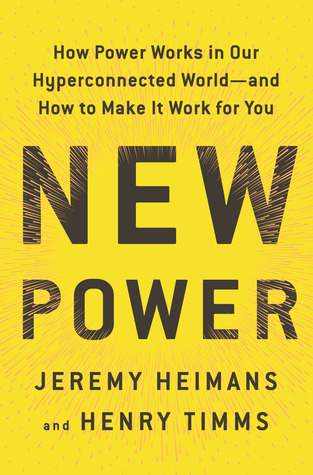More on this book
Community
Kindle Notes & Highlights
Read between
December 17, 2018 - November 20, 2019
the boundaries between their work and their lives tend to be blurry.
Of course, there is a dark side to this founder feeling.
The one part of the founder’s experience that most people do not want to share—yet do—is the ...
This highlight has been truncated due to consecutive passage length restrictions.
people no longer feel secure in their roles and aren’t seeing the kind of long-term commitment from employers that loyal employees could count on in the postwar era.
job security was second only to money as the millennials’ greatest motivation in choosing a role.
All these desires and anxieties are placing great strains on the old power model, which delivers very little agency, information, engagement, and flexibility for t...
This highlight has been truncated due to consecutive passage length restrictions.
It really feels like your own business…You
This online community is much more vibrant than the
usual corporate intranet
because in a world without managers, peer support becomes key to professional develop...
This highlight has been truncated due to consecutive passage length restrictions.
Holacracy
is a radical new management philosophy and system, invented by software engineers,
Zappos took it so much to heart that it restructured the entire company, eliminating bosses ...
This highlight has been truncated due to consecutive passage length restrictions.
Holacracy is highly structured and directive, perhaps more so than many old power organizations.
Restrictions and protocols, with a good sprinkle of jargon, become the focus
under Holacracy, not the work itself.
Holacracy is like new power for robots.
it puts human beings front and center. It focuses on how to get teams of people to form deep connections with one another
By the end of 2020, two of every three respondents hope to have moved on, while only 16 percent of Millennials see themselves with their current employers a decade from now.”—Deloitte
When you understand the draw of the founder feeling, it’s no surprise that many workers at big organizations are increasingly impatient to move up or move on.
Hoffman wants to put a stop to what he sees as the biggest lie the workplace tells us: We are a family.
We shouldn’t think of our workplace commitment as we do our marriage vows,
Instead we should frame the employee-employer relationship as an “alliance,” made up of short and cl...
This highlight has been truncated due to consecutive passage length restrictions.
Once each tour is complete, it will often be renewed, but sometimes it will
see the employee move on, with both sides better for it.
addressing what is also a big challenge for the old power workplace:
how to capture value from the many people who aren’t looking to make a decades-long commitment to one employer.
once your tour of duty is over, your relationship with the company is not.
LinkedIn wants its alums to refer people it should hire, act as ambassadors, share ideas, and help shape and protect the company reputation.
Those organizations that want to build robust alumni networks will have to first mak...
This highlight has been truncated due to consecutive passage length restrictions.
proud graduates whose loyalty will endure beyond the...
This highlight has been truncated due to consecutive passage length restrictions.
There is increasing risk today for organizations whose former employees are ready to rise up ...
This highlight has been truncated due to consecutive passage length restrictions.
Not only are workers becoming more transient, work itself is becoming more atomized and impermanent.
The contingent workforce is growing rapidly, thanks in part to the rise of “gig economy” platforms.
up to 40 percent of the U.S. workforce can now be counted as contingent.
The challenges of managing contingent and gig economy workers may be a glimpse into the future of management generally.
If you’re a company with a large share of contingent workers (or your business model is dependent on them), the tropes of traditional HR can seem rather quaint. The standard reviews and performance development plans that worked in the old power world don’t make sense for a large, distributed, and contingent workforce.
Such businesses rely on an initial layer of what we can think of as
algorithmic management;
the very design of their platforms allows them to enforce rules and create incenti...
This highlight has been truncated due to consecutive passage length restrictions.
Customer rating systems stand in for performance reviews. Allowing workers to rate customers can maintain moral...
This highlight has been truncated due to consecutive passage length restrictions.
But algorithmic management alone will only go so far. Creating a human connection among workers on a vast scale will also be critical.
Gig economy platforms are shaping expectations about work and working conditions, and mostly for the worse.
In Fiverr’s world, founders can look to some a little more like serfs.
As we look to the future of work, it’s easy to imagine a bifurcation: the vast majority of work shaped by the financial logic of automation and the mathematical logic of the algorithm, alongside a small number of hyper-empowered “founders” with tremendous agency, access to capital, and capacity to innovate.
But we should reject the idea that our destiny is to end up either being replaced by robots or treated like them.
We believe there’s a practical advantage—and a moral imperative—to designing platforms t...
This highlight has been truncated due to consecutive passage length restrictions.
that offer worker protections and security, provide freedom and dignity, and release creat...
This highlight has been truncated due to consecutive passage length restrictions.
“Carr-Benkler wager.”
More than a decade after it was made, the wager remains unsettled.


